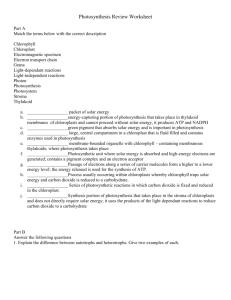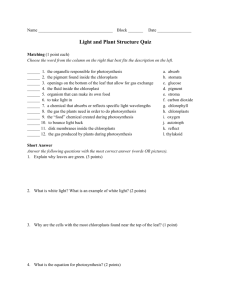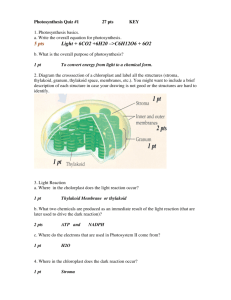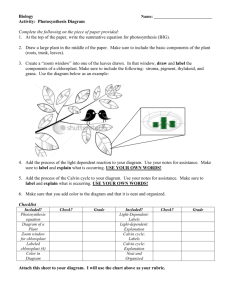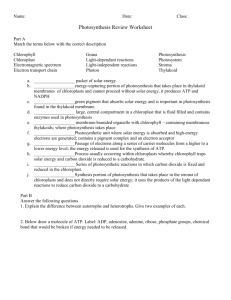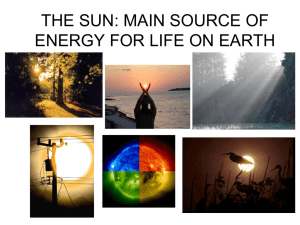Photosynthesis Review Worksheet
advertisement
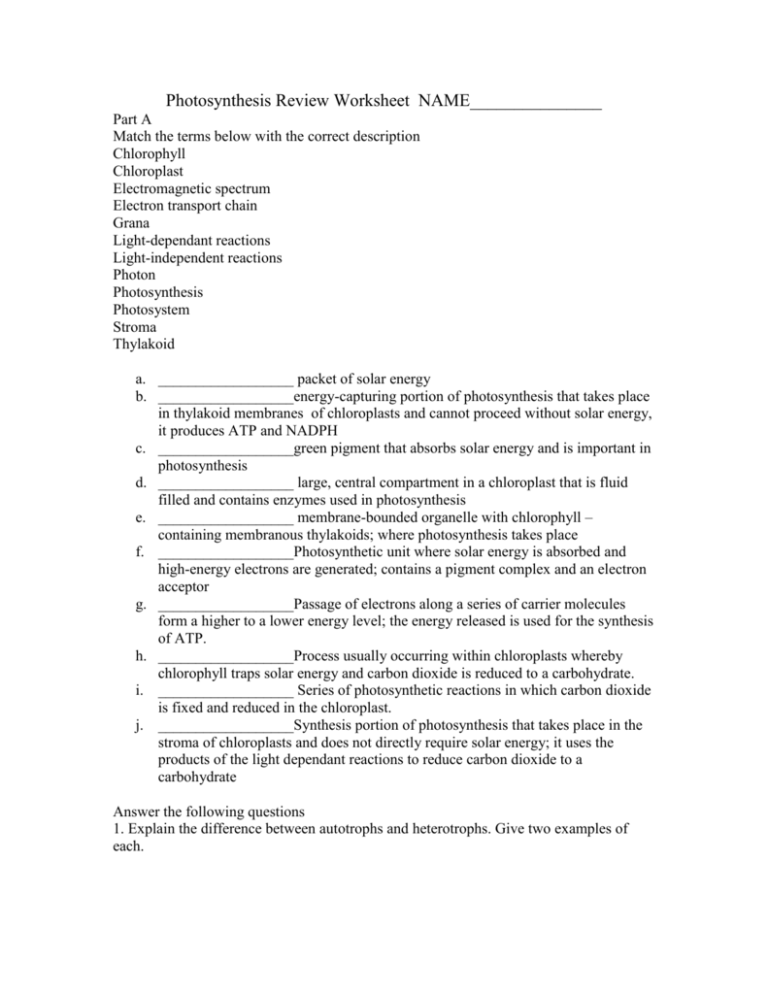
Photosynthesis Review Worksheet NAME_______________ Part A Match the terms below with the correct description Chlorophyll Chloroplast Electromagnetic spectrum Electron transport chain Grana Light-dependant reactions Light-independent reactions Photon Photosynthesis Photosystem Stroma Thylakoid a. __________________ packet of solar energy b. __________________energy-capturing portion of photosynthesis that takes place in thylakoid membranes of chloroplasts and cannot proceed without solar energy, it produces ATP and NADPH c. __________________green pigment that absorbs solar energy and is important in photosynthesis d. __________________ large, central compartment in a chloroplast that is fluid filled and contains enzymes used in photosynthesis e. __________________ membrane-bounded organelle with chlorophyll – containing membranous thylakoids; where photosynthesis takes place f. __________________Photosynthetic unit where solar energy is absorbed and high-energy electrons are generated; contains a pigment complex and an electron acceptor g. __________________Passage of electrons along a series of carrier molecules form a higher to a lower energy level; the energy released is used for the synthesis of ATP. h. __________________Process usually occurring within chloroplasts whereby chlorophyll traps solar energy and carbon dioxide is reduced to a carbohydrate. i. __________________ Series of photosynthetic reactions in which carbon dioxide is fixed and reduced in the chloroplast. j. __________________Synthesis portion of photosynthesis that takes place in the stroma of chloroplasts and does not directly require solar energy; it uses the products of the light dependant reactions to reduce carbon dioxide to a carbohydrate Answer the following questions 1. Explain the difference between autotrophs and heterotrophs. Give two examples of each. 2. Below draw a molecule of ATP. Label: ADP, adenosine, adenine, ribose, phosphate groups, chemical bond that would be broken if energy needed to be released. 3. Below draw a diagram of chloroplast and label the following: chloroplast membrane, thylakoid, granum (grana), stroma, thylakoid membrane, thylakoid innerspace, location of pigments. 4. Explain why chloroplasts are green. 5. What is NADPH? What is the difference between NADP+ and NADPH? How does NADP+ turn into NADPH? 6. Write the chemical equation for the process of photosynthesis. 7. What are the reactants and products of Light Dependant Reactions? Where in the chloroplast do they occur? Reactants: Products: Location: 8. What are the reactants and products of Light-Independent Reactions? Where in the chloroplast do they occur? Reactants: Products: Location: 9. Describe the Light-Dependant reaction. 10. What are the beginning and ending products for Photosystem I and Photosystem II? 11. Describe the purpose for photosystem I and photosystem II. 12. When a water molecule is split, what is it split into? Where do all the resulting components end up? 13. At what steps of L-D reactions is ATP made. What is it specifically used for? (this will be different depending when and where is it produced) 14. Describe the action of protein carrier: ATP synthase? Explain why is it important to build up a Hydrogen ion concentration gradient in order to have it properly function? 15. What are Light-Independent Reaction often called? 16. Why is there a need to go on with Light – Independent reactions? Why not stop with the Light –Dependant Reactions since ATP and NADPH are energy carrying molecules? 17. Where does the Carbon Dioxide come from? What will happen to it and what will it eventually become? 18. How many molecules of carbon dioxide enter one Calvin Cycle? How many molecules of high-energy sugars are produced as a result of one Calvin Cycle? 19. Explain why the trees lose their leaves in the fall.

